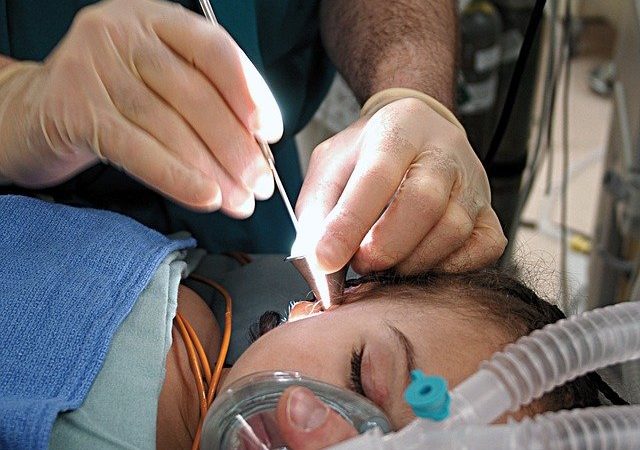WHAT IS EAR TUBE SURGERY?
Ear tubes are tiny tubes made of metal or plastic and they are shaped like a small spool of thread. During ear tube surgery, a small hole is made in the eardrums and the tubes are inserted. The opening to the middle ear (the area behind the eardrum) lets air flow in and out. This keeps air pressure even between the middle ear and the outside and helps to drain fluid that builds up behind the eardrum.
Most kids will not need surgery to have a tube taken out later because ear tubes usually fall out on their own, pushed out as the eardrum heals. A tube generally stays in the ear anywhere from 6 months to 2 years, depending on the type of tube used. If the tube stays in the eardrum beyond 2-3 years, your doctor might choose to remove them surgically.
WHY IS EAR TUBE SURGERY DONE?
Many kids get middle ear infections (otitis media). This often happens when a child has a cold or other respiratory infection. Bacteria or viruses can enter the middle ear and fill it with fluid or pus. When fluid pushes on the eardrum, it can cause an earache and affect hearing. Long periods of decreased hearing in young children can lead to delays in speech development. Children who get recurrent ear infections are sometimes sent for hearing tests.
A doctor may suggest ear tube surgery if a child gets many ear infections that do not clear up easily, or if the ear infections seem to be causing hearing loss or speech delay. Ear tube surgery is effective because it can drain fluid from the middle ear, prevent future infections, and help the child hear properly again.
WHAT HAPPENS BEFORE EAR TUBE SURGERY?
You may not eat or drink anything, including water, after midnight the night before your surgery. If these instructions are not followed, your surgery may be cancelled.
WHAT HAPPENS DURING EAR TUBE SURGERY?
This surgery is done in an operating room while your child is under anesthesia. The anesthesiologist will carefully watch your child and keep him or her safely and comfortably asleep during the procedure. The surgeon will make a small hole in each eardrum and remove fluid from the middle ear using suction.
Because the surgeon can reach the eardrum through the ear canal, there are no visible cuts or stitches. The surgeon will finish by putting the small metal or plastic tube into the hole in the eardrum. The surgeon then instills medicated eardrops into the ear canal and places a cotton ball in the ear. This procedure usually takes less than 10 minutes.
WHAT HAPPENS AFTER EAR TUBE SURGERY?
Your child will wake up in the recovery area. In most cases, the total time spent in the hospital is a few hours. Younger children or those with other medical problems may stay longer.
Your child may vomit a little on the day of surgery or have a minor earache. Some children’s ears will pop when they burp, yawn, or chew. This is normal and should go away as the eardrum heals.
Ear tubes help prevent ear infections by allowing air into the middle ear. Other substances such as water may sometimes enter through the tube, but this is rarely a problem if they are bathing or swimming in shallow water. Your surgeon will recommend earplugs for when swimming in a depth of more than 3 feet of water.
It is important to know that ear tubes will not prevent all ear infections, but they can make them milder and happen less often. In some cases, the tubes might need to be put in again.
It is OK for your child to travel in airplanes after having ear tubes placed. The ear will help even out air pressure inside and outside the ear.
ARE THERE ANY RISKS FROM HAVING EAR TUBE SURGERY?
This is a common and safe procedure, although there are risks with any surgery, including infection, bleeding, and problems with anesthesia. Rarely the hole in the eardrum does not close after the tube comes out and might need to be surgically repaired.
HOW CAN PARENTS HELP AFTER EAR TUBE SURGERY?
Your doctor will send you home with eardrops to use after the surgery, give them as directed. Be sure to warm bottle in hands for at least 30 seconds so eardrops will be body temperature before instilling in child’s ears.
Your child can return to a regular diet at home and can return to normal activities after a day of rest.
You might see a small amount of fluid draining from the ears for a couple of days. You can place a clean cotton ball in the opening of each ear to catch the drainage, but do not stick cotton swabs in the ears.
Your child should avoid blowing his/her nose too hard.
YOU SHOULD CALL THE DOCTOR IF:
- Your child cannot keep any fluids down or keeps vomiting
- Develops a fever
- Has new ear pain or pain that does not go away with medicine
- The prescribed ear drops cause discomfort
- One or both of your child’s ears drain for more than 7 days after surgery
- Your child has yellowish-green ear drainage, or has a bad smell coming from his/her ear
- Ear tube falls out in the first few weeks
See the doctor right away or go to the emergency room if there is a lot of blood in the ear drainage or if the ear pain is severe.
How to Schedule an Appointment
Premier ENT is Minden Medical Center’s newest clinic. Call Dr. Watkins at 318.716.1111 to make an appointment. For more information about his clinic, visit Premier ENT.
Premier ENT
1000 Chinaberry Dr. Suite 1103
Bossier City, LA 71111
For Appointments, Call: 318.716.1111



